Stromal heterogeneity may explain increased incidence of metaplastic breast cancer in women of African descent
- PMID: 37709737
- PMCID: PMC10502140
- DOI: 10.1038/s41467-023-41473-6
Stromal heterogeneity may explain increased incidence of metaplastic breast cancer in women of African descent
Abstract
The biologic basis of genetic ancestry-dependent variability in disease incidence and outcome is just beginning to be explored. We recently reported enrichment of a population of ZEB1-expressing cells located adjacent to ductal epithelial cells in normal breasts of women of African ancestry compared to those of European ancestry. In this study, we demonstrate that these cells have properties of fibroadipogenic/mesenchymal stromal cells that express PROCR and PDGFRα and transdifferentiate into adipogenic and osteogenic lineages. PROCR + /ZEB1 + /PDGFRα+ (PZP) cells are enriched in normal breast tissues of women of African compared to European ancestry. PZP: epithelial cell communication results in luminal epithelial cells acquiring basal cell characteristics and IL-6-dependent increase in STAT3 phosphorylation. Furthermore, level of phospho-STAT3 is higher in normal and cancerous breast tissues of women of African ancestry. PZP cells transformed with HRasG12V ± SV40-T/t antigens generate metaplastic carcinoma suggesting that these cells are one of the cells-of-origin of metaplastic breast cancers.
© 2023. Springer Nature Limited.
Conflict of interest statement
The authors declare no competing interests.
Figures
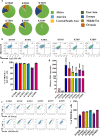


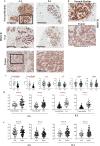
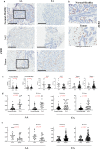

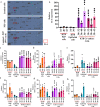
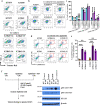

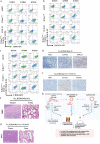
Similar articles
-
Normal Breast-Derived Epithelial Cells with Luminal and Intrinsic Subtype-Enriched Gene Expression Document Interindividual Differences in Their Differentiation Cascade.Cancer Res. 2018 Sep 1;78(17):5107-5123. doi: 10.1158/0008-5472.CAN-18-0509. Epub 2018 Jul 11. Cancer Res. 2018. PMID: 29997232 Free PMC article.
-
Dual TGFβ/BMP Pathway Inhibition Enables Expansion and Characterization of Multiple Epithelial Cell Types of the Normal and Cancerous Breast.Mol Cancer Res. 2019 Jul;17(7):1556-1570. doi: 10.1158/1541-7786.MCR-19-0165. Epub 2019 Apr 16. Mol Cancer Res. 2019. PMID: 30992305 Free PMC article.
-
The N-terminal polypeptide derived from viral macrophage inflammatory protein II reverses breast cancer epithelial-to-mesenchymal transition via a PDGFRα-dependent mechanism.Oncotarget. 2017 Jun 6;8(23):37448-37463. doi: 10.18632/oncotarget.16394. Oncotarget. 2017. PMID: 28415580 Free PMC article.
-
Breast cancer disparities: high-risk breast cancer and African ancestry.Surg Oncol Clin N Am. 2014 Jul;23(3):579-92. doi: 10.1016/j.soc.2014.03.014. Surg Oncol Clin N Am. 2014. PMID: 24882352 Review.
-
Molecular alterations in metaplastic breast carcinoma.J Clin Pathol. 2013 Jun;66(6):522-8. doi: 10.1136/jclinpath-2012-201086. Epub 2013 Jan 31. J Clin Pathol. 2013. PMID: 23372178 Review.
Cited by
-
Signaling Pathway Alterations Driven by BRCA1 and BRCA2 Germline Mutations are Sufficient to Initiate Breast Tumorigenesis by the PIK3CAH1047R Oncogene.Cancer Res Commun. 2024 Jan 5;4(1):38-54. doi: 10.1158/2767-9764.CRC-23-0330. Cancer Res Commun. 2024. PMID: 38059556 Free PMC article.
-
Fibroblast proximity to a tumor impacts fibroblast extracellular vesicles produced by 3D bioprinted stromal models.Biomater Sci. 2025 Jul 8;13(14):3814-3827. doi: 10.1039/d4bm01569j. Biomater Sci. 2025. PMID: 40492327 Free PMC article.
-
Single-nucleus chromatin accessibility and transcriptomic map of breast tissues of women of diverse genetic ancestry.Nat Med. 2024 Dec;30(12):3482-3494. doi: 10.1038/s41591-024-03011-9. Epub 2024 Aug 9. Nat Med. 2024. PMID: 39122969 Free PMC article.
-
STAT3 Signaling Pathway in Health and Disease.MedComm (2020). 2025 Mar 30;6(4):e70152. doi: 10.1002/mco2.70152. eCollection 2025 Apr. MedComm (2020). 2025. PMID: 40166646 Free PMC article. Review.
-
CD105+ fibroblasts support an immunosuppressive niche in women at high risk of breast cancer initiation.Breast Cancer Res. 2025 May 15;27(1):81. doi: 10.1186/s13058-025-02040-7. Breast Cancer Res. 2025. PMID: 40375322 Free PMC article.
References
Publication types
MeSH terms
Substances
LinkOut - more resources
Full Text Sources
Medical
Research Materials
Miscellaneous

